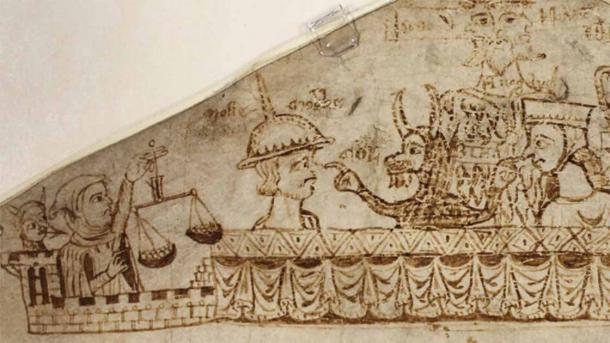[ad_1]
Ashkenazi Jews, who migrated into Holy Roman Empire territories around the 1st millennium AD, also settled in parts of England but how they were treated is less understood. Now, genome analysis of human remains recovered from a medieval well in Norwich has revealed evidence that 17 Ashkenazi Jews were murdered in a gruesome act of antisemitism.
Archaeologists called to examine the medieval well remains in central Norwich in 2004 immediately felt that the stratigraphic position of the remains and the completeness of the skeletons suggested that a single event had led to their deposition.
In fact, evidence shows they were thrown into the well right after they were murdered, as they were deposited headfirst into a dry well that was less than half a meter (1.64 feet) deep and one meter (3.3 feet) in diameter. The children were thrown into the well after the adults, as their bones were not as damaged as the adult skeletons.
In a new study published in Current Biology , a team of researchers were able to shed new light on antisemitism in the medieval ages. This new research also found evidence of the first appearance of certain genetic disorders frequently found in Ashkenazi Jews, revealing more about Jewish medical history in Europe.

A digital reconstruction of the remains discovered in the medieval well in Norwich that led to the conclusion that these people were the victims of antisemitism. (Professor Caroline Wilkinson / Liverpool John Moores University )
Antisemitism Derived From DNA and Historical Reconstruction
Ashkenazi Jews settled in Germany and in Italy sometime before the 12th century AD. Today, Ashkenazi Jews make up 80% of the world’s Jewish population, according to DW.
“I’m really excited that 12 years on [from our first investigations], we’ve finally been able to use historical records, archaeology and ancient DNA analyses to shed new light on a historical crime, and in doing so sequenced the oldest genomes from a Jewish population,” said Dr Selina Brace, lead author of the study, who works at London’s Natural History Museum.
In 2004, construction workers excavating in preparation for the Chapelfield shopping center development recovered human skeletal remains from an unused well. The remains consisted of six adults and eleven children, according to the press release .
“The overrepresentation of subadults and the unusual location of the burial outside of consecrated ground suggested that they may have been victims of a mass fatality event such as famine, disease, or mass murder ,” the authors of the study stated.
Four of the 17 humans found in the well were closely related: three sibling sisters aged 5-15, and one young adult.
DNA analysis also showed that one young male child had blue eyes and red hair , which are historical European Jewish traits.
Six of the individuals had strong DNA connections with modern day Jews residing in the UK.
“It’s been over 12 years since we started looking into who these people are, and the technology finally caught up with our ambition,” said evolutionary geneticist and study co-author Ian Barnes of the Natural History Museum, London. “Our main job was to establish the identity of those individuals at the ethnic level.”

In this antisemitic sketch in the National Archives, which was drawn in the margin of an English revenue record and dated to 1233, caricatured Jewish people are accosted by a demon. ( The National Archives )
The Crusades and Ashkenazi Jewish Migration
Evidence of antisemitism in medieval England is not new. In 1144, the family of William of Norwich alleged that local Jews were responsible for his murder, which was an argument later taken forward by the infamous Benedictine monk , Thomas of Monmouth. And historical records show that before the Third Crusade , English Jews were murdered during antisemitic riots in the early 1190s. Antisemitism exists even today, reports The Jerusalem Post .
“The possibility that the remains found at the Chapelfield well site were those of the victims of antisemitic violence is given further support by the site’s location just to the south of the medieval Jewish quarter of the city,” wrote the authors of the study.
It was after the crusades of 11th-13th centuries that the Ashkenazi Jews began migrating eastwards to Slavic lands like Poland, Lithuania, Russia. It was only after the 17th-century persecution of Jews in eastern Europe that descendants of these Jews would resettle and assimilate again in Western Europe.
“It was quite surprising that the initially unidentified remains filled the historical gap about when certain Jewish communities first formed and the origins of some genetic disorders,” concluded evolutionary geneticist and co-author Mark Thomas of the University College London.
“Nobody had analyzed Jewish ancient DNA before because of prohibitions on the disturbance of Jewish graves. However, we did not know this until after doing the genetic analyses.”
Top image: A digital reconstruction of the remains discovered in the disused well that DNA analysis revealed to be Jewish individuals who were the victims of antisemitism in medieval England. Source: Professor Caroline Wilkinson / Liverpool John Moores University
By Sahir Pandey
References
Abbany, Z. 2022. 17 bodies found at shopping mall construction site were medieval Ashkenazi Jews . Available at: https://www.dw.com/en/17-bodies-found-at-shopping-mall-construction-site-were-medieval-ashkenazi-jews/a-62969497.
Brace, S., Diekmann, Y., et al . 2022. Genomes from a medieval mass burial show Ashkenazi-associated hereditary diseases pre-date the 12th century. Current Biology. Available at: https://doi.org/10.1016/j.cub.2022.08.036.
Cell Press. 2022. Medieval mass burial shows centuries-earlier origin of Ashkenazi genetic bottleneck . Available at: https://www.sciencedaily.com/releases/2022/08/220830131610.htm.
Davis, N. 2022. Jewish remains found in Norwich well were medieval pogrom victims – study . Available at: https://www.theguardian.com/science/2022/aug/30/jewish-remains-found-in-norwich-well-were-medieval-pogrom-victims-study.
Prillaman, M. 2022. Genomics solves the mystery of a medieval mass burial . Available at: https://www.nature.com/articles/d41586-022-02356-w.
Siegel-Itzkovich, J. 2022. Skeleton examinations reveal 1000-year-old antisemitic violence – study . Available at: https://www.jpost.com/archaeology/article-715841.
Tonkin, S. 2022. Seventeen human bodies found at the bottom of a medieval well in Norwich were a group of Ashkenazi Jews who may have been victims of antisemitic violence during the 12 th century, DNA study reveals. Available at: https://www.dailymail.co.uk/sciencetech/article-11160231/Human-bodies-medieval-Norwich-group-Ashkenazi-Jews.html.
[ad_2]
Source link
